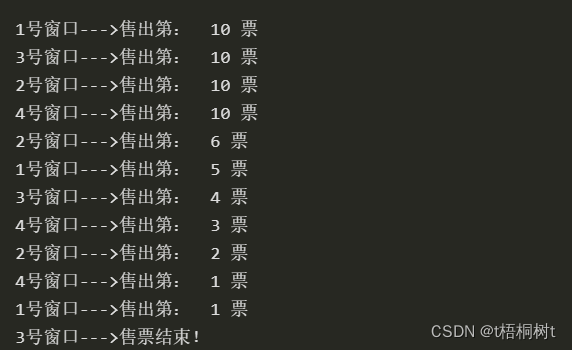一个程序在运行起来的时候会转换成进程,通常含有多个线程。
通常情况下,一个进程中的比较耗时的操作(如长循环、文件上传下载、网络资源获取等),往往会采用多线程来解决。
比如显示生活中,银行取钱问题、火车票多个售票窗口的问题,通常会涉及到并发的问题,从而需要多线程的技术。
当进程中有多个并发线程进入一个重要数据的代码块时,在修改数据的过程中,很有可能引发线程安全问题,从而造成数据异常。例如,正常逻辑下,同一个编号的火车票只能售出一次,却由于线程安全问题而被多次售出,从而引起实际业务异常。
现在我们就以售票问题来演示线程安全的问题
在不对多线程数据进行保护的情况下会引发的状况
public class ThreadUnSecurity {
static int tickets = 10;
class SellTickets implements Runnable{
@Override
public void run() {
// 未加同步时产生脏数据
while(tickets > 0) {
System.out.println(Thread.currentThread().getName()+"--->售出第: "+tickets+" 票");
tickets--;
try {
Thread.sleep(1000);
} catch (InterruptedException e) {
e.printStackTrace();
}
}
if (tickets <= 0) {
System.out.println(Thread.currentThread().getName()+"--->售票结束!");
}
}
}
public static void main(String[] args) {
SellTickets sell = new ThreadUnSecurity().new SellTickets();
Thread thread1 = new Thread(sell, "1号窗口");
Thread thread2 = new Thread(sell, "2号窗口");
Thread thread3 = new Thread(sell, "3号窗口");
Thread thread4 = new Thread(sell, "4号窗口");
thread1.start();
thread2.start();
thread3.start();
thread4.start();
}
}

同步代码块
import com.sun.org.apache.regexp.internal.recompile;
public class ThreadSynchronizedSecurity {
static int tickets = 10;
class SellTickets implements Runnable{
@Override
public void run() {
// 同步代码块
while(tickets > 0) {
synchronized (this) {
// System.out.println(this.getClass().getName().toString());
if (tickets <= 0) {
return;
}
System.out.println(Thread.currentThread().getName()+"--->售出第: "+tickets+" 票");
tickets--;
try {
Thread.sleep(100);
} catch (InterruptedException e) {
e.printStackTrace();
}
}
if (tickets <= 0) {
System.out.println(Thread.currentThread().getName()+"--->售票结束!");
}
}
}
}
public static void main(String[] args) {
SellTickets sell = new ThreadSynchronizedSecurity().new SellTickets();
Thread thread1 = new Thread(sell, "1号窗口");
Thread thread2 = new Thread(sell, "2号窗口");
Thread thread3 = new Thread(sell, "3号窗口");
Thread thread4 = new Thread(sell, "4号窗口");
thread1.start();
thread2.start();
thread3.start();
thread4.start();
}
}
同步方法
public class ThreadSynchroniazedMethodSecurity {
static int tickets = 10;
class SellTickets implements Runnable{
@Override
public void run() {
//同步方法
while (tickets > 0) {
synMethod();
try {
Thread.sleep(100);
} catch (InterruptedException e) {
// TODO Auto-generated catch block
e.printStackTrace();
}
if (tickets<=0) {
System.out.println(Thread.currentThread().getName()+"--->售票结束");
}
}
}
synchronized void synMethod() {
synchronized (this) {
if (tickets <=0) {
return;
}
System.out.println(Thread.currentThread().getName()+"---->售出第 "+tickets+" 票 ");
tickets-- ;
}
}
}
public static void main(String[] args) {
SellTickets sell = new ThreadSynchroniazedMethodSecurity().new SellTickets();
Thread thread1 = new Thread(sell, "1号窗口");
Thread thread2 = new Thread(sell, "2号窗口");
Thread thread3 = new Thread(sell, "3号窗口");
Thread thread4 = new Thread(sell, "4号窗口");
thread1.start();
thread2.start();
thread3.start();
thread4.start();
}
}
Lock锁机制
import java.util.concurrent.locks.Lock;
import java.util.concurrent.locks.ReentrantLock;
public class ThreadLockSecurity {
static int tickets = 10;
class SellTickets implements Runnable{
Lock lock = new ReentrantLock();
@Override
public void run() {
// Lock锁机制
while(tickets > 0) {
try {
lock.lock();
if (tickets <= 0) {
return;
}
System.out.println(Thread.currentThread().getName()+"--->售出第: "+tickets+" 票");
tickets--;
} catch (Exception e1) {
// TODO Auto-generated catch block
e1.printStackTrace();
}finally {
lock.unlock();
try {
Thread.sleep(100);
} catch (InterruptedException e) {
e.printStackTrace();
}
}
}
if (tickets <= 0) {
System.out.println(Thread.currentThread().getName()+"--->售票结束!");
}
}
}
public static void main(String[] args) {
SellTickets sell = new ThreadLockSecurity().new SellTickets();
Thread thread1 = new Thread(sell, "1号窗口");
Thread thread2 = new Thread(sell, "2号窗口");
Thread thread3 = new Thread(sell, "3号窗口");
Thread thread4 = new Thread(sell, "4号窗口");
thread1.start();
thread2.start();
thread3.start();
thread4.start();
}
}
